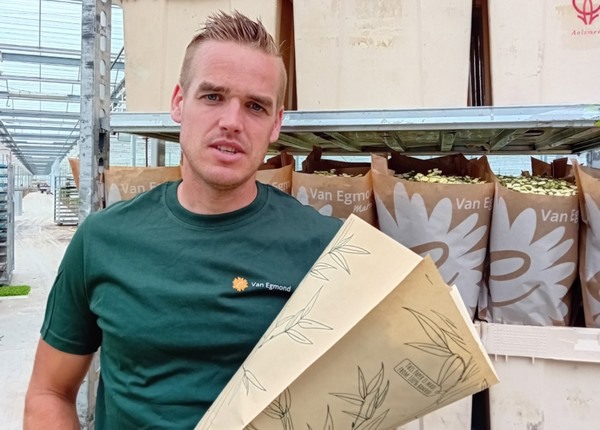While many companies use plastic sleeves around flowers, Van Egmond Matricaria opted for paper sleeves last year. What advantages do these offer and what are the experiences of using them? Royal FloraHolland asks Johan van Egmond, a second-generation grower at this family business in Bleiswijk, the Netherlands.

Van Egmond has been growing matricarias, cut flowers with a profusion of yellow or yellow-white buds and a familiar spicy fragrance, for almost 40 years. They are available year-round. ‘Our products are mainly used as supplementary blooms in bouquets, so the sleeves come off at the florist’, Van Egmond explains. ‘The supplier of our covers came and asked if paper sleeves would be an option for us. Customers were also asking for it. So, the company made the decision to transition last year.’
More sustainable and natural appearance
What are the advantages and disadvantages of paper? ‘The big advantage is that this packaging is much more sustainable in terms of waste disposal. Enquiries with Renewi revealed that printed plastic in particular cannot be reused at a high quality level. We also wondered about digestibility, should the materials unexpectedly end up in the natural world. We conducted tests ourselves, burying a plastic and a paper sleeve in our growing soil for eight weeks. The outcome was clear: plastic did not decompose (as expected) and the paper did. The paper did not decompose completely in this short time, but the process was already well advanced.’ In addition, the grower cites a more natural look as an advantage of paper. ‘Presentation also plays an important role. Paper also helps to drain moisture. With plastic, everything gets a bit sweaty.’
Paper is more expensive than plastic
A major drawback is cost: paper is about 70% more expensive than plastic. ‘With us, it's not too bad relatively speaking, as 25 stems go into one sleeve. But if it’s just a few stems, then obviously it’s another story’, adds Van Egmond. At first, customers had to get used to the fact that the flower’s leaves are no longer visible. ‘But overall, the response has been very positive. We even received a note from a florist from England who is very enthusiastic about the paper sleeves, stating that the material is easier to handle.’ A final disadvantage is that paper is more susceptible to creasing. ‘You grab it and it's already creased. That doesn’t happen with plastic.’
Next step: covers made of bamboo
Van Egmond Matricaria is already working on the next step, which could also offer a solution for wrinkles: bamboo. ‘It looks like paper but is much more resilient in terms of creasing. And even more sustainable, as a bamboo plant grows much faster than a tree. It can be used in just six to eight months. Moreover, fewer pesticides are needed. Next year, we will commission the first covers made of bamboo.’ Does Van Egmond have any tips for other growers? ‘It’s important to just be open to ideas. There was quite a lot of criticism among growers about paper sleeves, but it is crucial to keep up with the latest developments as well.’
Royal FloraHolland helps make product packaging more sustainable
Royal FloraHolland guides growers in making sustainable packaging choices because choosing the right sustainable packaging is not easy. They therefore commissioned an independent life cycle assessment (LCA) quick-scan, which reveals how six different types of covers score on various environmental themes.
Source: Royal FloraHolland
